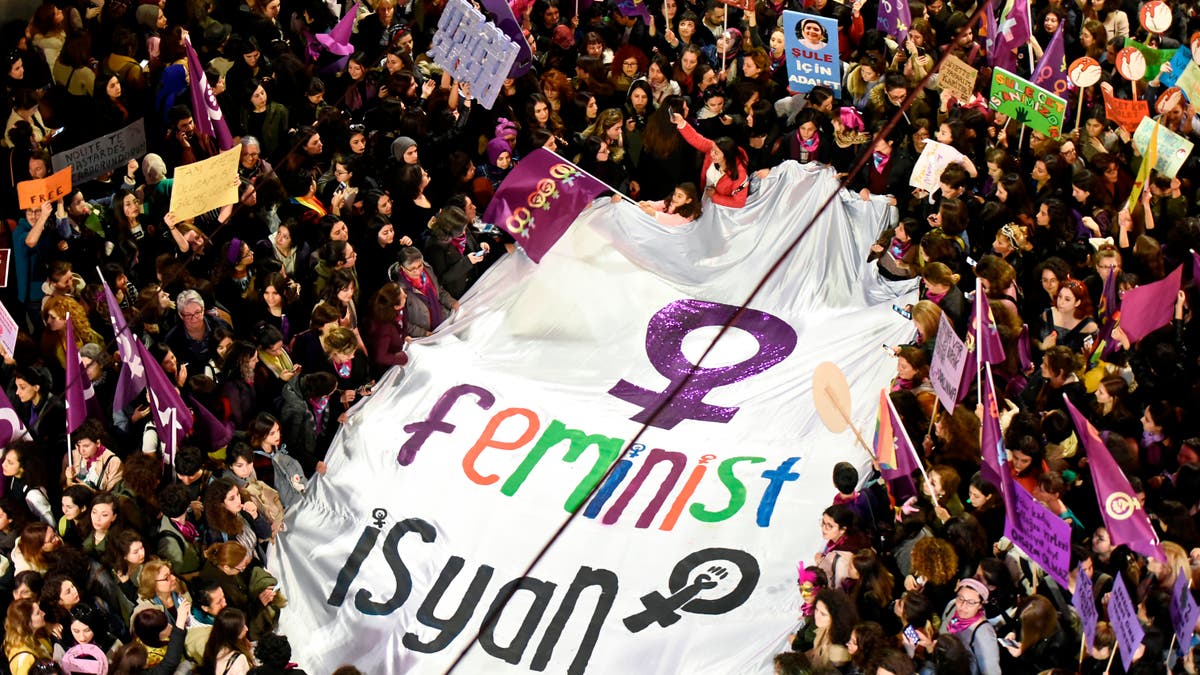Claressa Shields fights for equality in boxing: 'We're as great as the men'
Professional boxer and mixed martial artist Claressa Shields advocates for women's equality in her sport.
Happy International Women's Day! The global holiday celebrates the social, economic, cultural and political achievements of women worldwide.
International Women’s Day (IWD) has been observed for the last 110 years, honoring how far the women’s rights movement has come while rallying for a more equitable future.
Dozens of countries across the globe celebrate International Women's Day as a holiday to recognize the achievements of influential females who have activated for gender equality.
WOMEN'S HISTORY MONTH QUIZ! TEST YOUR KNOWLEDGE OF THE COMMEMORATIVE MONTH
The holiday has transitioned over the last few decades to recognize the progress made by the female empowerment and civil rights movements. The holiday's themes symbolize some of the most important issues facing modern female gender advocacy.
In honor of the special occasion, here are six facts to know about International Women's Day.
- International Women's Day began in 1911
- International Women’s Day is not group or organization specific
- Purple is International Women's Day's signature color
- International Women's Day is celebrated in many ways
- The 2023 theme for International Women's Day is #EmbraceEquity
- Numerous countries celebrate International Women's Day.
1. International Women's Day began in 1911

International Women's Day has been celebrated across the world for over a century. (Hulton-Deutsch Collection/Corbis via Getty Images)
The first IWD was held in 1911, celebrated in Austria, Denmark, Germany and Switzerland on March 19 by over a million people.
Official events in the inaugural celebration championed women's rights to vote, work and hold public office, while denouncing discrimination, according to the International Women's Day website.
Tragically, less than one week later, the Triangle Shirtwaist Factory Fire claimed the lives of over 140 working women in New York City. The disaster raised awareness of labor laws in the U.S. and unjust working conditions, further fueling IWD’s mission in the years that followed.
In 1913, IWD’s date was moved to March 8, a day on which it has been globally celebrated ever since.
2. International Women’s Day is not group-specific
The international crusade is not solely organized or operated by any one government, charity, corporation, NGO, academic institution, network or media group.
MATTEL RELEASES ELEANOR ROOSEVELT BARBIE DOLL BEFORE INTERNATIONAL WOMEN'S DAY
Instead, IWD marks an inclusive push for action and advocacy, "whatever that looks like globally at a local level."
3. Purple is International Women's Day's signature color

Purple is the signature color for International Women's Day. (YASIN AKGUL/AFP via Getty Images)
IWD says that purple symbolizes justice and dignity.
A combination of purple, green and white hues historically represented the push for women’s equality, dating back to the Women's Social and Political Union in the U.K. in about 1908. While green signified the virtue of hope, white connoted "purity."
In the U.S., the date March 8 is a highlight of Women's History Month, which was officially designated so by Congress in 1987.
Today, the color white is no longer used as the notion of "purity" is controversial, said IWD.
4. International Women's Day is celebrated in many ways
Around the world, IWD includes marches, rallies, speeches, conferences and performances, among other traditions.
In the U.S., the holiday is a highlight of Women's History Month, which was officially designated so by Congress in 1987.
Some women in China are given a half day of work on March 8, while the exchange of flowers — particularly mimosa blossoms — is popular in Russia and Rome, according to the BBC.
5. The 2023 theme for International Women's Day is #EmbraceEquity

The theme for International Women's Day changes every year to reflect the goals of the female liberation movement. (Universal History Archive/Universal Images Group via Getty Images)
The #EmbraceEquity theme on IWD demands that both men and women support balanced outcomes that are equitable to women.
The organization that runs IWD wants to educate individuals on the differences between equality and equity.
"The IWD 2023 #EmbraceEquity campaign theme seeks to get the world talking about why "equal opportunities are no longer enough" — and can in fact be exclusionary rather than inclusive," the organization states on the IWD website.
The group defines equality as an essential pillar of democracy in which everyone, regardless of race, gender, class or sexual orientation, has the same opportunity in society. However, equity is considered an essential element of a democracy, while "success is based on personal efforts and not social status."
Equity is the principle that not everyone starts life under the same circumstances; thus, achieving the same equal goals in life is harder.
This year, equity is at the forefront of International Women's Day as activists fight to progress society toward a more tolerant and gender-equal environment.
CLICK HERE TO GET THE FOX NEWS APP
Prior themes on the March holiday include #ChooseToChallenge in 2021, which called for speaking out against gender bias and inequality and supporting the advocacy of inclusivity.
In 2022, #BreakTheBias was the official theme for International Women's Day, focusing on combating divisive gender stereotypes, discrimination, and bias and promoting inclusivity and diversity.
6. Numerous countries celebrate International Women's Day
International Women's Day is celebrated throughout the United States with parades and activist events championing women's rights and gender equality. However, the United States does not recognize the March celebration as an official holiday.
CLICK HERE TO SIGN UP FOR OUR LIFESTYLE NEWSLETTER
Instead, the holiday is officially recognized in 19 countries, such as Russia, Ukraine, Afghanistan, Armenia, Cuba, China, Germany and Moldova.
Starting in 1975, the United Nations recognized International Women's Day to support female civil rights and equality across the globe. Two years later, in 1977, the U.N. General Assembly voted to make March 8 an official U.N. holiday.
Janine Puhak contributed reporting.


